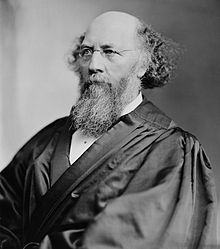Stephen Johnson Field: Difference between revisions
MisfitToys (talk | contribs) |
MisfitToys (talk | contribs) |
||
| Line 95: | Line 95: | ||
[[Category:Williams College alumni]] |
[[Category:Williams College alumni]] |
||
[[Category:People of California in the American Civil War]] |
[[Category:People of California in the American Civil War]] |
||
[[Category:People from Yuba County, California]] |
|||
[[Category:People from Connecticut]] |
[[Category:People from Connecticut]] |
||
Revision as of 01:03, 31 January 2008
This article includes a list of references, related reading, or external links, but its sources remain unclear because it lacks inline citations. |
Stephen Johnson Field | |
|---|---|
 | |
| Associate Justice of the United States Supreme Court | |
| In office May 20 1863 – December 1 1897 | |
| Nominated by | Abraham Lincoln |
| Preceded by | (none) |
| Succeeded by | Joseph McKenna |
| Personal details | |
| Spouse | Sue Virginia Field |
Stephen Johnson Field (November 4 1816 – April 9 1899) was an associate justice of the United States Supreme Court from May 20 1863, to December 1 1897. Prior to this, he was the 5th Chief Justice of the California Supreme Court.
Born in Haddam, Connecticut, he was the sixth of the nine children of David Dudley Field I, a Congregationalist minister, and his wife Submit Dickinson. He grew up in Stockbridge, Massachusetts, and went to Turkey at thirteen with his sister and her missionary husband. He graduated from Williams College, Williamstown, Massachusetts, in 1837. While attending Williams College he joined Delta Upsilon Fraternity. After studying law in New York City with his brother David Dudley Field II, they practiced law together until 1848 when he went west to California in the Gold Rush. There his legal practice boomed and he was elected alcalde, a form of mayor and justice of the peace under the old Mexican rule of law, of Marysville. Because the Gold Rush city could afford no jail, and it cost too much to transport prisoners to San Francisco, Field implemented the whipping post, believing that without such a brutal implement many in the rough and tumble city would be hanged for minor crimes. The voters sent him to the California State Assembly in 1850 to represent Yuba County, but he lost a race the next year for the State Senate. His successful legal practice led to his election to the California Supreme Court in 1857, serving six years.

Abraham Lincoln appointed him to the newly created tenth Supreme Court seat, to achieve both regional balance (he was a Westerner) and political balance (he was a Democrat, but a Unionist one). It would also give the Court someone familiar with real estate and mining issues.
He was a vocal proponent of the substantive due process theory that protected property rights from regulation under the Fourteenth Amendment--as illustrated in his dissents to the Slaughterhouse Cases and Munn v. Illinois. Field's views were eventually adopted by the court's majority, but only after his death. However, he helped end the income tax (Pollock v. Farmers' Loan and Trust Company), limit anti-trust law (United States v. E.C. Knight Company), and the power of the Interstate Commerce Commission.
On the issue of ethnic minorities, he had a mixed record. Field wrote opinions against California's laws discriminating against the Chinese immigrants to that state. However, Justice Field dissented in Strauder v. West Virginia, a case holding that the exclusion of African-Americans from a jury that convicted Strauder, an African-American, of murder, was a violation of the Fourteenth Amendment's Equal Protection Clause. He also joined the infamous case Plessy v. Ferguson that upheld racial segregation.
Field insisted on breaking John Marshall's record of thirty-three years on the court, even though he was not able to handle the workload. His colleagues asked him to resign due to his being intermittently senile[1] but he refused, staying on until 1897. He lived only two years more, dying in Washington, D.C., and was buried there in the Rock Creek Cemetery.
There was an assassination attempt on Justice Field by a former associate of his on the California Supreme Court, David S. Terry. Terry was shot and killed by Field's bodyguard. Ironically, legal issues arising from the shooting came before the Supreme Court in the 1890 habeas corpus case of In re Neagle. (See George C. Gorham, “The Story of the Attempted Assassination of Justice Field by a Former Associate on the Supreme Bench of California”, Journal of the Supreme Court Historical Society, Volume 30; Issue 2 (2005).)
See also
External links
Template:Start U.S. Supreme Court composition Template:U.S. Supreme Court composition 1863–1864 Template:U.S. Supreme Court composition CJ Template:U.S. Supreme Court composition 1864–1865 Template:U.S. Supreme Court composition 1865–1867 Template:U.S. Supreme Court composition 1867–1870 Template:U.S. Supreme Court composition 1870–1872 Template:U.S. Supreme Court composition 1873 Template:U.S. Supreme Court composition CJ Template:U.S. Supreme Court composition 1874–1877 Template:U.S. Supreme Court composition 1877–1880 Template:U.S. Supreme Court composition 1881 Template:U.S. Supreme Court composition 1882–1887 Template:U.S. Supreme Court composition 1888 Template:U.S. Supreme Court composition CJ Template:U.S. Supreme Court composition 1888–1889 Template:U.S. Supreme Court composition 1890–1891 Template:U.S. Supreme Court composition 1891–1892 Template:U.S. Supreme Court composition 1892–1893 Template:U.S. Supreme Court composition 1893 Template:U.S. Supreme Court composition 1894–1895 Template:U.S. Supreme Court composition 1896–1897 Template:End U.S. Supreme Court composition
